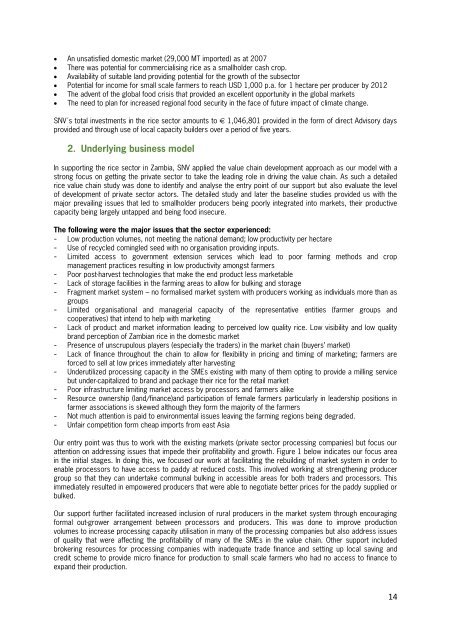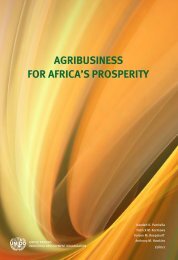Collection of Case Studies 2. - Seas of Change Initiative
Collection of Case Studies 2. - Seas of Change Initiative
Collection of Case Studies 2. - Seas of Change Initiative
You also want an ePaper? Increase the reach of your titles
YUMPU automatically turns print PDFs into web optimized ePapers that Google loves.
An unsatisfied domestic market (29,000 MT imported) as at 2007 There was potential for commercialising rice as a smallholder cash crop. Availability <strong>of</strong> suitable land providing potential for the growth <strong>of</strong> the subsector Potential for income for small scale farmers to reach USD 1,000 p.a. for 1 hectare per producer by 2012 The advent <strong>of</strong> the global food crisis that provided an excellent opportunity in the global markets The need to plan for increased regional food security in the face <strong>of</strong> future impact <strong>of</strong> climate change.SNV´s total investments in the rice sector amounts to € 1,046,801 provided in the form <strong>of</strong> direct Advisory daysprovided and through use <strong>of</strong> local capacity builders over a period <strong>of</strong> five years.<strong>2.</strong> Underlying business modelIn supporting the rice sector in Zambia, SNV applied the value chain development approach as our model with astrong focus on getting the private sector to take the leading role in driving the value chain. As such a detailedrice value chain study was done to identify and analyse the entry point <strong>of</strong> our support but also evaluate the level<strong>of</strong> development <strong>of</strong> private sector actors. The detailed study and later the baseline studies provided us with themajor prevailing issues that led to smallholder producers being poorly integrated into markets, their productivecapacity being largely untapped and being food insecure.The following were the major issues that the sector experienced:- Low production volumes, not meeting the national demand; low productivity per hectare- Use <strong>of</strong> recycled comingled seed with no organisation providing inputs.- Limited access to government extension services which lead to poor farming methods and cropmanagement practices resulting in low productivity amongst farmers- Poor post-harvest technologies that make the end product less marketable- Lack <strong>of</strong> storage facilities in the farming areas to allow for bulking and storage- Fragment market system – no formalised market system with producers working as individuals more than asgroups- Limited organisational and managerial capacity <strong>of</strong> the representative entities (farmer groups andcooperatives) that intend to help with marketing- Lack <strong>of</strong> product and market information leading to perceived low quality rice. Low visibility and low qualitybrand perception <strong>of</strong> Zambian rice in the domestic market- Presence <strong>of</strong> unscrupulous players (especially the traders) in the market chain (buyers’ market)- Lack <strong>of</strong> finance throughout the chain to allow for flexibility in pricing and timing <strong>of</strong> marketing; farmers areforced to sell at low prices immediately after harvesting- Underutilized processing capacity in the SMEs existing with many <strong>of</strong> them opting to provide a milling servicebut under-capitalized to brand and package their rice for the retail market- Poor infrastructure limiting market access by processors and farmers alike- Resource ownership (land/finance)and participation <strong>of</strong> female farmers particularly in leadership positions infarmer associations is skewed although they form the majority <strong>of</strong> the farmers- Not much attention is paid to environmental issues leaving the farming regions being degraded.- Unfair competition form cheap imports from east AsiaOur entry point was thus to work with the existing markets (private sector processing companies) but focus ourattention on addressing issues that impede their pr<strong>of</strong>itability and growth. Figure 1 below indicates our focus areain the initial stages. In doing this, we focused our work at facilitating the rebuilding <strong>of</strong> market system in order toenable processors to have access to paddy at reduced costs. This involved working at strengthening producergroup so that they can undertake communal bulking in accessible areas for both traders and processors. Thisimmediately resulted in empowered producers that were able to negotiate better prices for the paddy supplied orbulked.Our support further facilitated increased inclusion <strong>of</strong> rural producers in the market system through encouragingformal out-grower arrangement between processors and producers. This was done to improve productionvolumes to increase processing capacity utilisation in many <strong>of</strong> the processing companies but also address issues<strong>of</strong> quality that were affecting the pr<strong>of</strong>itability <strong>of</strong> many <strong>of</strong> the SMEs in the value chain. Other support includedbrokering resources for processing companies with inadequate trade finance and setting up local saving andcredit scheme to provide micro finance for production to small scale farmers who had no access to finance toexpand their production.14







